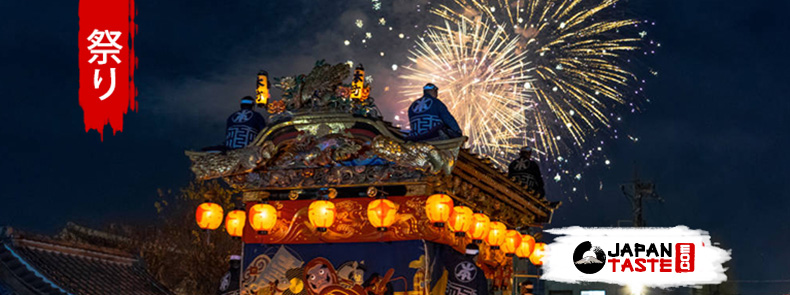Matsuri, national holidays or traditional festivals, are numerous in Japan throughout the year, especially in spring and summer. These holidays are often linked to a Shinto religious celebration.
Japanese people like to go there with their families, couples or friends and some of them like to come dressed in traditional clothes like yukata, a light kimono. You will find many food stalls called yatai. Here is a non-exhaustive list of sweet and savory dishes that can be found during these festivals.
Summary:
- Japanese savory dishes during a matsuri in Japan
- Japanese sweet dishes during a matsuri in Japan
- Dates of the main matsuri in Japan
Japanese savory dishes :
Yakisoba 焼きそば, fried noodles
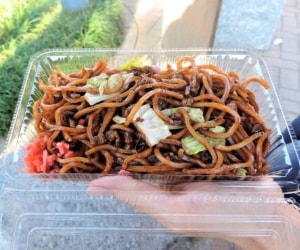 These arenoodles stir-fried on a hot plate, typical yatai dish, these noodles are delicious thanks to its Japanese otafuku sauce and beni shoga.
These arenoodles stir-fried on a hot plate, typical yatai dish, these noodles are delicious thanks to its Japanese otafuku sauce and beni shoga.
Takoyaki たこ焼き, octopus balls
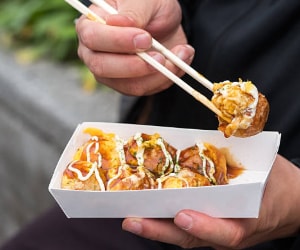 The takoyaki are small balls stuffed with octopus. You will find some with shrimp, these will then be called ebiyaki. It is a very common street dish in Osaka in particular. It is sold on the go, to be eaten hot with Otafuku sauce, Kewpie mayonnaise, Katsuobushi flakes and aonori seaweed! Find our takoyaki recipe to make at home! You don’t have a takoyaki mold? Then try our recipe for kakutako, a lesser known version of takoyaki to be made in a pan but just as tasty!
The takoyaki are small balls stuffed with octopus. You will find some with shrimp, these will then be called ebiyaki. It is a very common street dish in Osaka in particular. It is sold on the go, to be eaten hot with Otafuku sauce, Kewpie mayonnaise, Katsuobushi flakes and aonori seaweed! Find our takoyaki recipe to make at home! You don’t have a takoyaki mold? Then try our recipe for kakutako, a lesser known version of takoyaki to be made in a pan but just as tasty!
Frankfurter omelet オムレツフランク
 A Frankfurter skewer, is a sausage wrapped in a thin omelette on which ketchup and mayonnaise are added.
A Frankfurter skewer, is a sausage wrapped in a thin omelette on which ketchup and mayonnaise are added.
Okonomiyaki お好み焼き, Japanese savory pancake
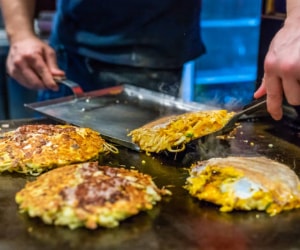 L’okonomiyaki is the big sister of takoyaki. Indeed, even if we can find it widely in the whole country, it is also very common in Osaka. It is a kind of thick pancake made of ingredients of your choice and topped with otafuku sauce, Kewpie mayonnaise, aonori and bonito flakes… A delight! It is to be noted that several versions exist and that according to the regions, the proposed ingredients are quite different! You will see that even these forms can evolve as with theHashimaki which we speak about below for example! You want to make this dish at home? Don’t hesitate to try our home-made okonomiyaki recipe!
L’okonomiyaki is the big sister of takoyaki. Indeed, even if we can find it widely in the whole country, it is also very common in Osaka. It is a kind of thick pancake made of ingredients of your choice and topped with otafuku sauce, Kewpie mayonnaise, aonori and bonito flakes… A delight! It is to be noted that several versions exist and that according to the regions, the proposed ingredients are quite different! You will see that even these forms can evolve as with theHashimaki which we speak about below for example! You want to make this dish at home? Don’t hesitate to try our home-made okonomiyaki recipe!
Yakitori 焼き鳥, chicken skewers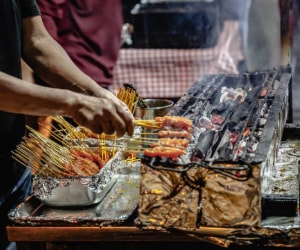 . Already well known in France, the yakitori are very popular in matsuri, they are grilled in front of you with charcoal. Even if the word yakitori means indeed grilled chicken, you will find in these stalls skewers of fish, vegetables, seafood…
. Already well known in France, the yakitori are very popular in matsuri, they are grilled in front of you with charcoal. Even if the word yakitori means indeed grilled chicken, you will find in these stalls skewers of fish, vegetables, seafood…
Ikayaki いか焼き, grilled cuttlefish
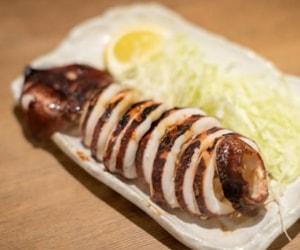 Ikayaki are cuttlefish grilled on a griddle and cut to be easily eaten on a skewer.
Ikayaki are cuttlefish grilled on a griddle and cut to be easily eaten on a skewer.
Hashimaki はしまき, okonomiyaki skewer
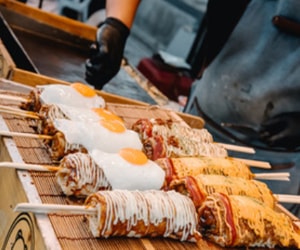 We have seen okonimiyaki above. Well here is the skewer version. Depending on the recipe and locality, we will find a horse egg on top and some negi chives…
We have seen okonimiyaki above. Well here is the skewer version. Depending on the recipe and locality, we will find a horse egg on top and some negi chives…
Yaki tomorokoshi 焼きとうもろこし, grilled corn
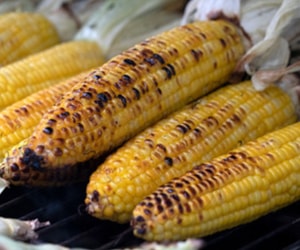 Very popular in Japan, corn will find its place during these events. The corn cobs will be grilled and most often seasoned with soy sauce and sometimes with melted butter on top. Butter and soy sauce go particularly well together…
Very popular in Japan, corn will find its place during these events. The corn cobs will be grilled and most often seasoned with soy sauce and sometimes with melted butter on top. Butter and soy sauce go particularly well together…
Karaage 唐揚げ, fried doughnut
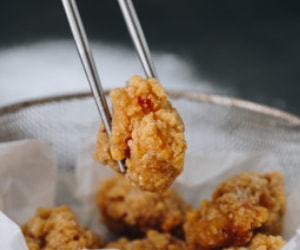 The karaage are small fried fritters made with meat, the most common and popular version is made with chicken. These fritters are very light and crispy at the same time. You’ve seen them all on sale in combinis.
The karaage are small fried fritters made with meat, the most common and popular version is made with chicken. These fritters are very light and crispy at the same time. You’ve seen them all on sale in combinis.
Tornado Potato トルネードポテト
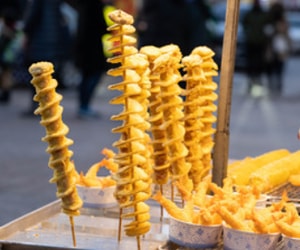 It is a potato skewer, cut in a very original way and fried like tempura. A classic that children love!
It is a potato skewer, cut in a very original way and fried like tempura. A classic that children love!
Agemochi 揚げもち, fried mochi
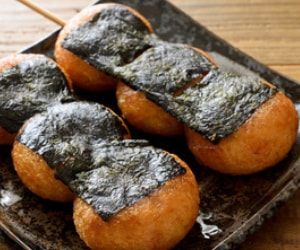 Agemochi are mochi (ball of sticky rice) fried in oil and seasoned with soy sauce. They form like most mochi a skewer of 3 mochi.
Agemochi are mochi (ball of sticky rice) fried in oil and seasoned with soy sauce. They form like most mochi a skewer of 3 mochi.
Amaguri 甘栗, roasted chestnut
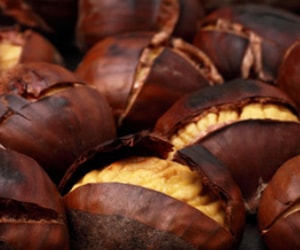 Here is a specialty that will not disorientate the French since we will find the traditional roasted chestnuts as we have them in France.
Here is a specialty that will not disorientate the French since we will find the traditional roasted chestnuts as we have them in France.
Glazed cucumber stick きゅうりの1本漬け
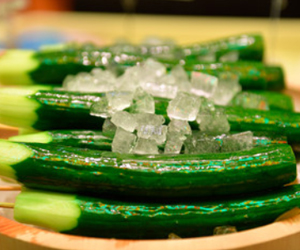 Surprising but yes you will find cucumber sticks placed on ice cubes so that they stay fresh. Finally when it is hot these cucumbers are very refreshing and healthy! These skewers are also common in Japanese markets. Generally speaking, as soon as it starts to get hot, the number of shops offering iced cucumber sticks increases.
Surprising but yes you will find cucumber sticks placed on ice cubes so that they stay fresh. Finally when it is hot these cucumbers are very refreshing and healthy! These skewers are also common in Japanese markets. Generally speaking, as soon as it starts to get hot, the number of shops offering iced cucumber sticks increases.
American dog アメリカンドッグ, fried hot dog stick
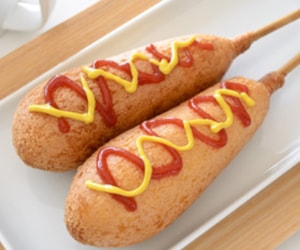 TheAmerican Dog is a sausage skewer surrounded by a thick batter fried in oil. On top is ketchup and karashi mustard in the manner of a classic hot dog.
TheAmerican Dog is a sausage skewer surrounded by a thick batter fried in oil. On top is ketchup and karashi mustard in the manner of a classic hot dog.
Guru-guru sausage ぐるぐるソーセージ
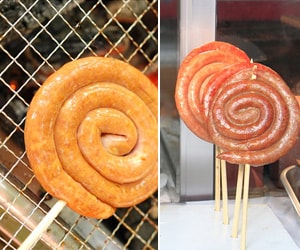 It is a grilled skewer with a sausage rolled up on it. We have never tried this version. The shape reminds us of the French charcuterie stalls… This does not invite us to taste it.
It is a grilled skewer with a sausage rolled up on it. We have never tried this version. The shape reminds us of the French charcuterie stalls… This does not invite us to taste it.
Crunchy pastry カリカリパスタ
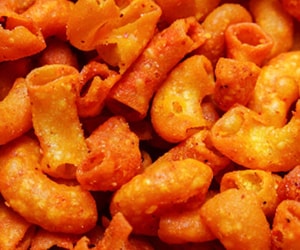 Simple and effective, it is fried pasta served with salt and pepper in a cone or in a basket. Light and crispy, it is easy to make at home!
Simple and effective, it is fried pasta served with salt and pepper in a cone or in a basket. Light and crispy, it is easy to make at home!
Sweet Japanese dishes:
Kakigori かき氷crushed ice
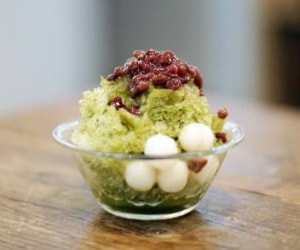 The kakigori is a very light and refreshing crushed ice cream. It is a very popular dessert in Japan and can be impressive by its size sometimes!
The kakigori is a very light and refreshing crushed ice cream. It is a very popular dessert in Japan and can be impressive by its size sometimes!
Japanese ice cream アイスクリーム
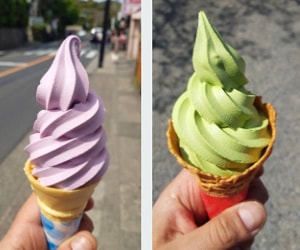 You will find many ice creams but with very different flavors from what we know such as black sesame ice cream, matcha ice cream, anko matcha ice cream, black tea ice cream! This last one is excellent by the way!
You will find many ice creams but with very different flavors from what we know such as black sesame ice cream, matcha ice cream, anko matcha ice cream, black tea ice cream! This last one is excellent by the way!
Wataame わたあめ, the cotton candy
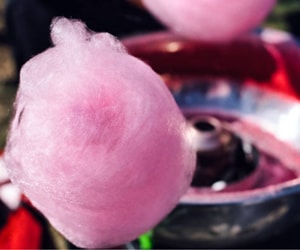 As in France, cotton candy is a classic of festivals in Japan. Cotton candy is called: Wataame, literally cotton candy!
As in France, cotton candy is a classic of festivals in Japan. Cotton candy is called: Wataame, literally cotton candy!
The love apple りんご飴
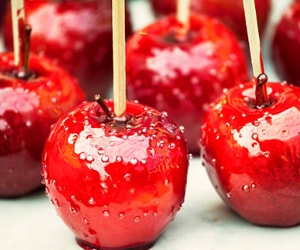 Another classic French dish, the “pomme d’amour”! Skewers of apples coated with a crunchy caramel.
Another classic French dish, the “pomme d’amour”! Skewers of apples coated with a crunchy caramel.
Sweet potato fries さつまスティック
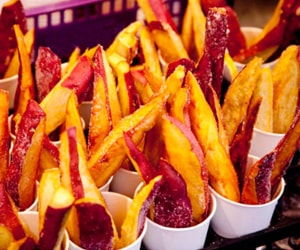 These Japanese sweet potatoes are fried in oil on which sugar is sprinkled. It is very good! Indeed the sweet potato goes very well with sugar and the Japanese have understood it well. We find the sweet potato in candy, ice cream and even big brand such as kitkat offers in Japan versions with sweet potato.
These Japanese sweet potatoes are fried in oil on which sugar is sprinkled. It is very good! Indeed the sweet potato goes very well with sugar and the Japanese have understood it well. We find the sweet potato in candy, ice cream and even big brand such as kitkat offers in Japan versions with sweet potato.
Taiyaki たい焼き, fish-shaped cakes
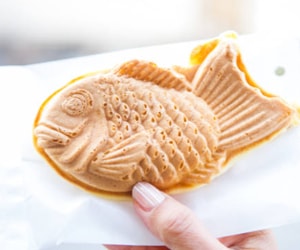 The taiyaki is a Japanese cookie in the shape of a sea bream often filled withanko, sweetened red bean paste, a very popular dessert! If you have a taiyaki mold, you can easily make it at home! Just follow our recipe for homemade anko!
The taiyaki is a Japanese cookie in the shape of a sea bream often filled withanko, sweetened red bean paste, a very popular dessert! If you have a taiyaki mold, you can easily make it at home! Just follow our recipe for homemade anko!
Japanese pancakes クレープ
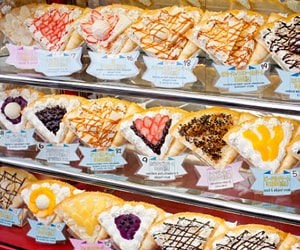 Very tasty pancakes with lots of fruits, creams, sauces, ice creams… The Japanese offer a huge choice of possibilities! And all the ones we tasted were delicious!
Very tasty pancakes with lots of fruits, creams, sauces, ice creams… The Japanese offer a huge choice of possibilities! And all the ones we tasted were delicious!
Chocolate bananas チョコバナナ
 Skewers of bananas colored and coated with chocolates. This is the Japanese version of the banana split!
Skewers of bananas colored and coated with chocolates. This is the Japanese version of the banana split!
Donguri Ame どんぐり飴, Japanese candy
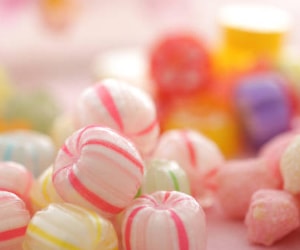 Very big hard candies, typical of festivals in Japan. There are different flavors. We could compare them to our fruit berlingots!
Very big hard candies, typical of festivals in Japan. There are different flavors. We could compare them to our fruit berlingots!
Baby Castella ベビーカステラ
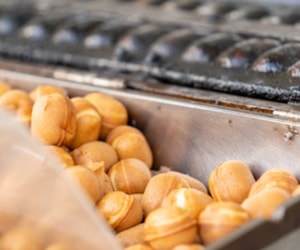 You know the castella ? A typical Japanese sponge cake, well here is the “baby” version. Unlike the castella which is really light and fluffy, the baby is crispy on the outside.
You know the castella ? A typical Japanese sponge cake, well here is the “baby” version. Unlike the castella which is really light and fluffy, the baby is crispy on the outside.
Karumeyaki カルメ焼き, Japanese honeyed sponge cake
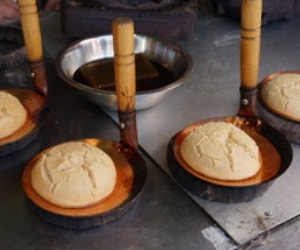 Karumeyaki is a traditional Japanese cake. It is baked in a small pan with corn syrup, sugar and baking soda until it is crispy. It has a texture similar to meringue.
Karumeyaki is a traditional Japanese cake. It is baked in a small pan with corn syrup, sugar and baking soda until it is crispy. It has a texture similar to meringue.
Mitarashi Dango みたらし団子, grilled mochi skewer
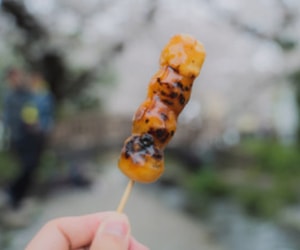 Mitarashi dango are skewers of grilled mochi balls seasoned with soy sauce for example. They are found everywhere and remain very popular in Japan.
Mitarashi dango are skewers of grilled mochi balls seasoned with soy sauce for example. They are found everywhere and remain very popular in Japan.
During these festivals Japanese people often accompany these dishes with Japanese beer! The atmosphere is very friendly, traditional thanks to the music and kimonos and magical with the fireworks! So if you plan a trip to Japan, don’t hesitate to go to a matsuri!

The dates of the main matsuri in Japan
Spring:
- Onbashira (御柱 or Onbashira-sai or Onbashira matsuri (御柱祭? in Suwa, from early April to early May once every six years.
- Sannō matsuri (山王祭) in Takayama on April 14 and 15, one of the three major festivals in Tokyo along with the Fukagawa matsuri and the Kanda matsuri.
- Sentei-sai (先帝祭) in Shimonoseki on May 3 and 4.
- Aoi matsuri (葵祭) in Kyoto, May 15.
- Kanda matsuri (神田祭) in Tokyo, the second Sunday of May. One of the three major festivals in Tokyo along with the Fukagawa matsuri and the Sannō matsuri
- Sanja matsuri (三社祭) in Tokyo, the third weekend of every May in Asakusa.
Summer:
- Otaue shinji (御田植神事) or Otaue matsuri (御田植祭) in Osaka on June 14.
- Tenjin matsuri (天神祭) in Osaka on July 24 and 25.
- Gion matsuri (祇園祭) in Kyoto’s Gion district in July. It is one of the three major festivals in Japan with Kanda matsuri and Tenjin matsuri.
- Hakata Gion yamakasa (博多祇園山笠) in Hakata, from July 1 to 15.
- Akita kanto matsuri in Akita from August 3 to 6.
- Aomori nebuta matsuri (青森ねぶた祭) in Aomori, August 2 to 7.
- Sendai tanabata matsuri (仙台七夕まつり) in Sendai, August 6-8.
- Yosakoi matsuri (よさこい祭り) in Kōchi, August 9-12.
- Awa-odori (阿波踊り) in Tokushima, August 12-15.
- Gozan no okuribi (京都五山送り火) in Kyoto, August 16.

Autumn:
- Kaze no bon (越中おわら風の盆) in Toyama, September 1-3.
- Danjiri matsuri (楽車祭) in Kishiwada, the second weekend of September.
- Naha ōtsunahiki (那覇大綱挽), also called Naha matsuri in Naha, from the second Saturday to the second Monday of October.
- Jidai matsuri (時代祭) in Kyoto, October 22. Parade of thousands of people in old-fashioned costumes.
- Ise-jingū kannamesai (伊勢神宮神嘗祭) and nīnamesai (新嘗祭) in Ise, October 15-25 and November 23-29.
Winter:
- Chichibu yomatsuri, in Chichibu on December 3.
- Namahage (なまはげ) in Oga, December 31.
- Narita-san setsubun-e (成田山節分会) in Narita for Setsubun, February 3.
- Hadaka matsuri (裸祭り) of Saidai-ji eyō (西大寺会陽) in Okayama on the third Saturday of February.
- Sapporo yuki matsuri (さっぽろ雪まつり, Sapporo Snow Festival) in Sapporo in mid-February.


